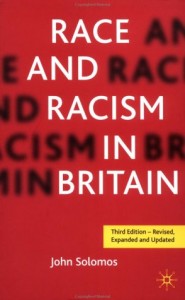 I’m sure that for sociology students, this book is a very valuable text. It’s very methodical and thorough – it looks at its subject from every angle, and almost every paragraph contains at least one reference to a book in the large bibliography at the end.
I’m sure that for sociology students, this book is a very valuable text. It’s very methodical and thorough – it looks at its subject from every angle, and almost every paragraph contains at least one reference to a book in the large bibliography at the end.
For me, though, the book was a bit of a struggle. Although I have often thought I would have liked a life in academia, to tell the truth I am not suited for it. I don’t like the dry, passive, non-committal tone, the judgements wrapped in so many caveats and clarifications that they become almost completely opaque.
I understand why academic writing is often like that. Spend years immersed in any subject and your knowledge becomes so extensive that to communicate it in plain language must be a challenge. With every argument you immediately anticipate the potential counter-argument, and so counter it pre-emptively with a counter-counter-argument which, itself, seems incomplete without reference to another idea which also needs buttressing by facts and references and footnotes and a thorough consideration of all possible objections.
There’s a lot to admire about such thoroughness, but it makes for a dull read. I came to this book just wanting to learn a bit more about race and racism in Britain, but often got bogged down in historiography. The parts that really came alive for me were when Solomos started talking about real-life stories.
For example, I was very interested in the coverage of Irish immigration. If you read the tabloids, you’d believe that immigration is a new issue, but Irish immigration goes back 200 years. And, most interestingly, the numbers are far greater than those for other groups. Yet, while Irish immigrants encountered extensive discrimination, there was little state intervention to prevent or regulate Irish immigration. In the mid to late twentieth century, though, immigration from former Commonwealth countries resulted in a huge backlash and draconian anti-immigrant legislation – the numbers were much smaller, but the colour of the skin was different.
The situation with Jewish immigrants at the beginning of the twentieth century in some ways anticipated the response to later Commonwealth immigration. Jews were used as scapegoats for unemployment and economic problems, and Parliament passed the Aliens Order restricting immigration and giving the Home Secretary the power to expel “undesirable” immigrants. Again, the numbers were relatively small – 120,000 between 1870 and 1914 – but they were more recognisably different, foreign, “alien”.
Again in the early post-war years, the majority of immigrants to the UK were from other European countries, and yet the arrival of much smaller numbers from the West Indies caused heated debate about the “colour problem”. Immigration and race became intertwined, and to this day they haven’t been disentangled (though these days, Muslims are the new black).
I was amazed to see how little has changed in anti-immigrant arguments. Here’s a quote from The Times, September 1958, in the aftermath of the Notting Hill riots:
There are three main causes of resentment against coloured inhabitants of the district. They are alleged to do no work and to collect a rich sum from the Assistance Board. They are said to find housing when white residents cannot. And they are charged with all kinds of misbehaviour, especially sexual.
This sounds a lot like the views of your average BNP member today. It doesn’t matter that there are no government agencies queuing up to give lazy immigrants housing and “rich sums”. It doesn’t matter that most immigrants work incredibly hard to get a foothold in this country, often while supporting family in their home country as well. The image of immigrants living in palaces on taxpayers’ money and committing crimes in their spare time is a persistent one.
Why? For the same reason as with the Jews 100 years ago. White working-class people are getting a raw deal, and they know it. So they are encouraged to believe that the fault lies not with the people getting rich off their labour, but with the Jews, the blacks, the Muslims. It doesn’t make any sense, but it doesn’t need to – it appeals at a level much deeper than that.
Of course, none of this is stated so overtly in the book. It’s my own reading and interpretation. Solomos words it all much more carefully, in paragraphs like this one from the summary and conclusion to chapter 3:
The story of post-1945 responses to immigration covered in this chapter shows how popular responses and state policy making have been shaped by specific national and local political situations. The circumstances that bring about particular types of policy response are not predetermined but are the product of policy agendas and ideologies, both within and outside state institutions. During the period covered in this chapter state responses to immigration were by no means uniform, although some patterns can be identified. We need to know more about the dynamics and the limits of state intervention in this field if we are to understand how the interplay between immigration and the state led to racist immigration controls becoming institutionalised.
My own conclusion is that I learned a lot from this book about racism in Britain and the development of state policies on race and immigration, but I felt that the dry academic style of writing sometimes hindered rather than helped my understanding. I liked the example of Irish immigration, although since Ireland was in the nineteenth century a part of the United Kingdom I am not sure what the state could have done to stem immigration, or even if it really counts as immigration. I would also be interested to see, in a future edition, what Solomos makes of more recent Eastern European immigration – in the early 21st century there has been quite a backlash against Poles and other Eastern European immigrants since their countries joined the EU and they were able to work and live in the UK. They are white Europeans so you can’t really call it racism, but it seems very similar to the earlier discussions of the “colour problem”.


